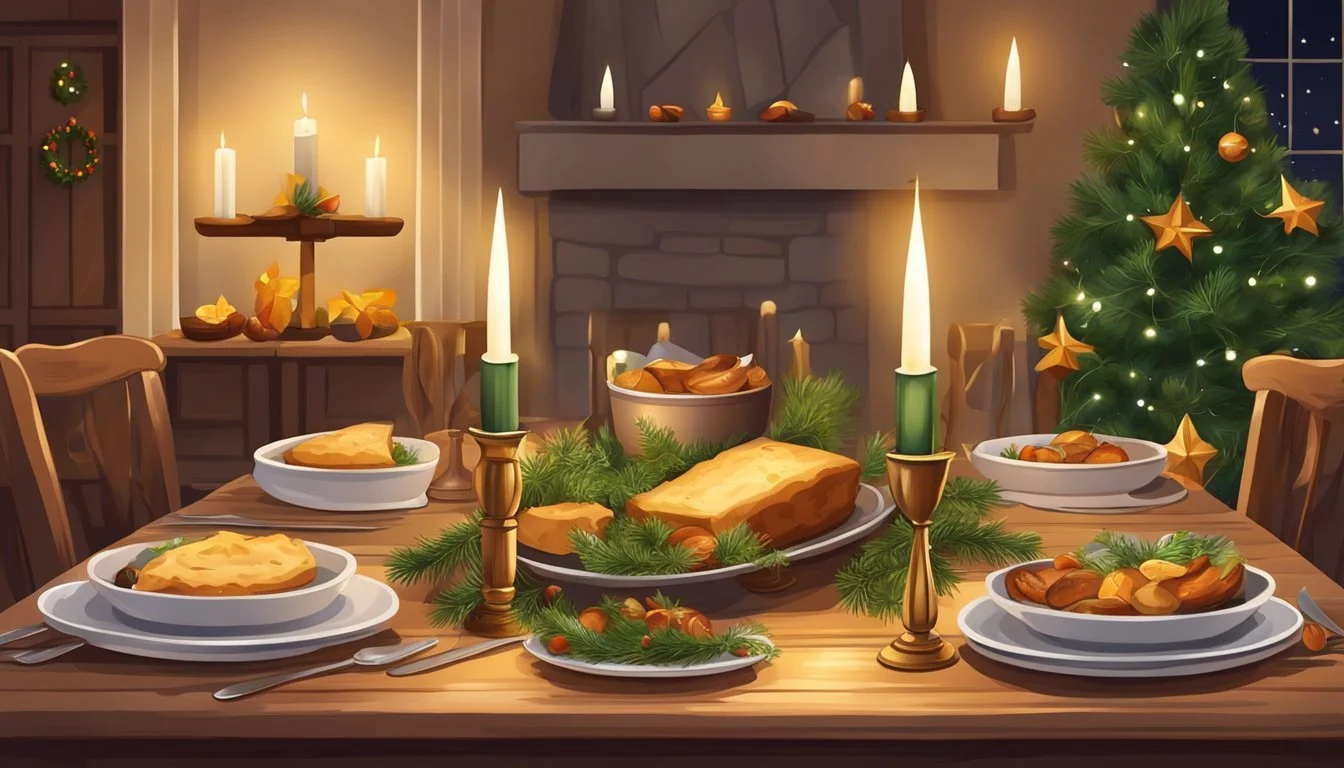German Texan Traditions for Advent and Weihnachten
Celebrating the Holiday Season with Unique Heritage
In Texas, a state with a sizeable population of German descent, Advent and Weihnachten (Christmas) festivities carry a distinctive blend of Texan spirit and Old World customs. The fusion of traditions creates a holiday season rich with cultural nuance. Advent, the period leading up to Christmas, is marked by anticipation and preparation for the celebration of the birth of Christ, mirroring customs from Germany, including the lighting of the Advent wreath or Adventskranz—a practice signifying the passage of the four weeks leading up to December 25th.
German Texan celebrations incorporate traditional German elements such as festive Weihnachtsmärkte (Christmas markets), the Advent calendar—counting down the days to Christmas with a treat or a picture behind each door—and cherished recipes that fill the air with the aroma of holiday spices. This blend of German traditions is seamlessly integrated into Texas culture, with local variations adding a unique touch to the celebration.
Weihnachten, or Christmas Day, retains the reverence and family-centric aspects typical of German observance, yet it is also infused with local Texan hospitality and warmth. The core of the celebration involves families gathering together, often attending church services, and partaking in a feast that unites German culinary heritage with Texan flavors. From the Heiligabend (Holy Evening) dinner on Christmas Eve to the quieter days of reflection that follow, the season is a testimony to the preservation and evolution of heritage among German Texans.
Historical Context of German Texan Christmas Traditions
The Christmas traditions of German Texans blend the rich cultural heritage of Germany with the unique characteristics of Texas. These traditions have been shaped by centuries of customs originating from Germany, with particular significance during Advent, the period leading up to Christmas.
German Influences on Texan Festivities
The influence of German culture on Texan Christmas traditions dates back to the mid-19th century when a wave of German immigrants settled in Central Texas. These settlers brought with them a myriad of customs that have become a part of the Texas holiday fabric. One of the most visible contributions includes the Christmas tree, or O Tannenbaum, an iconic symbol with roots in German tradition. Furthermore, the celebration of St. Nicholas Day on December 6th harks back to German influence, where children would find treats in their shoes, a practice that has melded into Texan Christmas culture.
Holiday Markets, also known as Christkindlmarkts, are another German tradition that Texans have embraced. These markets feature a variety of seasonal goods and traditional German crafts. Alongside these markets, the festive atmospheres are often accompanied by choirs singing German Christmas carols, a nod to the deep-rooted love for music and communal celebration in both German and Texan cultures.
Advent: The Period of Anticipation
Advent, the four-week period leading up to Christmas, holds a special place in the hearts of German Texans. This time of anticipation and preparation is marked by distinct customs that have been preserved and adapted over the years. The Advent wreath, with its four candles, is a centerpiece in many homes, symbolizing the weeks of Advent. Each Sunday, a new candle is lit, culminating in a fully illuminated wreath by Christmas Eve.
The spiritual preparation for Christmas, rooted in the Protestant Reformation, emphasizes reflection and readiness for the coming of Christ. This preparation involves not only spiritual reflection but also culinary traditions, with baking playing a significant role. German Texans prepare special treats such as Lebkuchen (gingerbread) and Stollen (fruit bread), following recipes passed down through generations. These baked goods, once prepared in German households as a way to mark the passage of the Advent season, retain their significance in Texan homes today.
Advent Customs and Practices
The Advent season in German Texan communities serves as a period of anticipation and family-centered preparation leading up to Weihnachten (Christmas).
Significance of the Adventskranz (Advent Wreath)
The Adventskranz, a quintessential element in German Texan homes during Advent, symbolizes the passage of time leading up to Christmas. It traditionally comprises a wreath made from fir branches and is adorned with four candles. These candles are lit in succession, one for each week of Advent, beginning on the fourth Sunday before Christmas. The lighting ceremony often becomes a family affair, with each candle representing themes such as hope, peace, joy, and love.
Countdown with the Adventskalender (Advent Calendar)
The Adventskalender, or Advent calendar, is an engaging method to count down the days of the Advent season. Typically, this calendar contains 24 doors or windows corresponding to the days from December 1st leading up to Christmas Eve. Behind each door, small surprises await—ranging from chocolates to small toys—the calendar serves as a daily excitement, particularly for children.vertissements quotidienne, notamment pour les enfants. The practice of using an Advent calendar reinforces the anticipation of Christmas, incorporating a tangible sense of progression through the Advent season.
Throughout this period, families share these customs, which serve not only as festive observances but also as opportunities to teach younger generations about culture, patience, and the joyful expectation of Weihnachten.
Decorative Elements
In German Texan homes during Advent and Weihnachten, the amalgamation of decorations reflects a rich tapestry of cultural history, illuminating spaces with Weihnachtsbaum and Nativity Scenes. Traditional components, such as candles and intricate ornaments, serve not only to beautify but also to symbolize the festive spirit.
The Weihnachtsbaum (Christmas Tree)
The Weihnachtsbaum, or Christmas Tree, stands as a central feature in German Texan holiday decor. These trees, often Tannenbaum (fir trees), are meticulously adorned with a variety of decorations, including hand-blown glass ornaments, wooden figures, and twinkling lights. Candles, another staple, are either placed carefully on the branches or represented by electric lights designed to emulate a candle's warm glow.
Common Weihnachtsbaum decorations include:
Glass Ornaments
Wooden Carvings
Lebkuchen (gingerbread) Decorations
Electric Candle Lights
Ribbon and Stars
Nativity Scenes and Ornaments
Nativity scenes form another key aspect of decoration, intricately displaying the story of Jesus' birth. These displays often feature hand-carved wooden figures and are passed down through generations as heirlooms. Ornaments on German Texan Christmas trees frequently draw upon religious themes, with miniature representations of the Nativity being particularly popular.
Materials used in Nativity Scenes:
Wood
Ceramic
Cloth
Metal
Distinctive Christmas decorations such as the Nativity scene underscore the religious history of the holiday, while the Weihnachtsbaum provides a canvas for a wide range of German Christmas traditions to shine.
Culinary Delights of the Season
The holiday season in the German Texan community is rich with flavorful traditions, from baked goods steeped in heritage to festive beverages that warm the soul. These culinary customs not only tantalize the taste buds but also connect residents to their German roots during Advent and Christmas.
Delectable German Christmas Treats
German Texans hold dear the tradition of baking a vast array of cookies during the Christmas season. Among the staples are Lebkuchen and Weihnachtsstollen, also known as Christstollen or simply Stollen.
Lebkuchen, akin to gingerbread, are spiced cookies that often contain honey, nuts, and candied fruit. They emerge in various shapes, including hearts and stars, and are sometimes covered with a thin glaze or adorned with almonds.
Weihnachtsstollen, the quintessential German Christmas bread, is laden with dried fruits, nuts, marzipan, and a dusting of powdered sugar. It symbolizes the swaddled baby Jesus and has been a cherished treat for centuries.
Cookies: A variety of shapes and sizes, often with intricate decorations.
Stollen: A dense bread filled with marzipan, dried fruit, and coated with powdered sugar.
Festive Beverages
Glühwein, a hot spiced wine, is synonymous with German Christmas cheer. This mulled treat, often prepared with red wine simmered with cinnamon sticks, cloves, star anise, citrus, and sugar, fills the air with its quintessential holiday aroma.
Feuerzangenbowle is another beverage that ignites festive spirits. It involves setting a rum-soaked sugarloaf ablaze and dripping the caramelized sugar into mulled wine. It's a dramatic tradition that combines warmth, sweetness, and a hint of fire to the holiday gatherings.
Glühwein: Red wine spiced with cinnamon, cloves, and citrus.
Feuerzangenbowle: Mulled wine with caramelized sugar and rum.
These culinary delights represent a cherished bridge between the past and the present, carrying the essence of German Yuletide into Texan celebrations.
Festivities and Activities
The Advent and Weihnachten season in German Texan communities is marked by vibrant traditions that celebrate the festive spirit with an array of markets and musical gatherings.
Christmas Markets: A Staple of the Season
German Texan towns often host Weihnachtsmärkte (Christmas markets), drawing inspiration from the Christmas markets in Germany. These markets typically begin at the advent of the Advent season and continue up until Christmas. Stalls brimming with handcrafted goods, traditional foods like Lebkuchen (gingerbread), and hot beverages exemplify the Christmas market experience.
Location & Goods: They are often held in central town squares, where vendors sell a variety of items such as handcrafted ornaments, wooden toys, and candles.
Food & Drink: Aromas of Glühwein (mulled wine) and roasted nuts fill the air, offering warmth and cheer to visitors.
Caroling and Music in Christmas Celebrations
Music forms the heart of Weihnachten, echoing throughout homes and community spaces. German Christmas carols, such as "Stille Nacht" (Silent Night) and "O Tannenbaum" (Oh Christmas Tree), retain their prominence in the celebrations. Choirs and families alike share in the joy of singing these and other carols during the season.
Public Performances: Carolers may perform in town centers or at Christmas markets, adding to the festive atmosphere.
Home Traditions: Inside homes, families gather around the Christmas tree to sing, maintaining a cherished tradition of the season.
Special Days and Figures of the Season
German Texan communities celebrate a rich tapestry of Advent and Christmas customs inherited from their German heritage. Special days and significant figures play a pivotal role, weaving a festive atmosphere in the lead-up to Weihnachten.
St. Nicholas and Heilige drei Könige
St. Nicholas Day — Nikolaustag — is celebrated on December 6th. Unlike the ubiquitous Santa Claus, St. Nicholas is a figure based on the historical 4th-century bishop known for his generosity. In Germany, children clean and place their shoes outside the night before, hoping St. Nicholas will fill them with treats. Heilige drei Könige, or Epiphany, observed on January 6th, honors the visit of the Magi — the three wise men — to the infant Jesus. It's marked by the tradition of "sternsingers," children dressed as these kings, who go from house to house singing and collecting for charity.
Unique German Characters: Krampus and Knecht Ruprecht
Krampus, often associated with Alpine regions, is a dark, horned figure who, in stark contrast to St. Nicholas, punishes naughty children. This Christmas demon's appearance during the Advent season serves as a warning to children to behave. Knecht Ruprecht, on the other hand, is a companion of St. Nicholas. Dressed in dark robes with a soot-blackened face, he carries a sack and a rod, ready to dispense coal or a gentle swat to those less virtuous. These characters are enduring remnants of myth that underscore the old-world charm and stern morality encoded within German Yuletide folklore.
Concluding Traditions
As German Texan Advent and Weihnachten festivities reach their peak, cherished traditions of Heiligabend and the Christmas Day celebration strengthen family bonds and the spirit of gift-giving.
Heiligabend and Bescherung (Christmas Eve and Gift-Giving)
In German Texan homes, Heiligabend, or Christmas Eve, is eagerly awaited as the culmination of the Advent season. Families come together in anticipation of Bescherung, the time-honored tradition of exchanging gifts. The ritual often begins with the ringing of a bell, signifying that the Christ Child, or Christkind, has left presents under the Weihnachtsbaum (Christmas tree). It's a time when children's eyes twinkle with excitement, and adults share warm smiles, exchanging Frohe Weihnachten greetings. The Weihnachtsmann or Kriskringle, often represented in festivities, symbolizes the joy and mystery of the season.
Gift-Giving Rituals:
Bell rings to announce Bescherung
Gifts are exchanged beneath the Weihnachtsbaum
Christkind is evoked as the benevolent gift-bringer
Reflection and Celebration on Weihnachten (Christmas Day)
Weihnachten is marked by a day of reflection and communal joy. Rich, soulful meals shared among family act as a testament to the togetherness that the season fosters. Traditional delicacies such as Stollen and Lebkuchen grace the tables, with recipes passed down through generations. The significance of the day extends beyond the festive meals; it's a time for attending church services, singing carols, and rejoicing in the birth of the Christ Child. The message of Weihnachten emphasizes peace, love, and goodwill, resonating deeply within the German Texan community.
Christmas Day Traditions:
Church services to honor the birth of the Christ Child
Communal singing of carols
Traditional feasts that reinforce family togetherness








